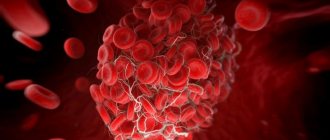Diagnosis of hereditary thrombophilia
It is very important to identify the pathology in advance, so testing for the presence of APS and genetic thrombophilia can be recommended for all women with a history of thrombosis, infertility and obstetric complications.
What does diagnostics include?
- 1. Study of the hemostasis system
- APTT (activated partial thromboplastin time);
- thromboelastogram (graphic information displayed by the TEG analyzer, measures 5 main parameters of clot formation and dissolution);
- aggregation (function) of platelets on 4 inducers (ADP, ristomycin, collagen, arachidonic acid);
- lupus anticoagulant;
- D-dimer and RKMP (markers of thrombosis);
- sail test (global test for determining disorders in the protein C system).
- enzyme-linked immunosorbent assay (ELISA test), which allows you to directly determine the concentration of antibodies to b2-glycoprotein I, prothrombin, annexin V, as well as the total level of all antiphospholipid antibodies.
- homocysteine test;
- blood test for proteins C and S and antithrombin 3 (hereditary deficiency of these natural anticoagulants is associated with an increased risk of vein thrombosis);
- determination of folic acid levels.
- 2. Genetic research, which includes a search for more than 20 mutations (genetic thrombophilias) and gene polymorphisms involved in the formation of a predisposition to hypercoagulability (increased blood clotting) and thrombosis during pregnancy.
Timely diagnosis, early anticoagulant and antiplatelet prophylaxis, an individual approach and selective therapy make it possible in the vast majority of cases to achieve successful pregnancy and pregnancy, preventing recurrent complications in the gestational period.
Treatment
During the examination, the doctor assesses the risk of a blood clot for the body. The threat is considered based on the following indicators:
- type of thrombophilia;
- the patient’s lifestyle, his age, weight, etc.;
- presence/absence of pregnancy;
- whether there was a similar situation in the past;
- susceptibility to thrombophilia (heredity).
Therapy for thrombophilia is aimed at suppressing the action of platelets. In order to prevent the formation of blood clots, low doses of aspirin are prescribed.
Anticoagulants are necessary to thin the blood. They transform the consistency of chemicals, thereby slowing down the blood clotting process. As a result, the blood clot does not dissolve under their influence, but the body’s self-healing mechanism is triggered, when, using certain forces, our body itself copes with the dissolution of blood clots. Most often, these drugs are used for venous thrombosis.
A special diet is prescribed, excluding fatty and fried foods.
Anticoagulant and antiplatelet therapy
To prevent venous thromboembolism, pregnant women are prescribed low molecular weight heparins (LMWH), the dosage of which depends on body weight and the recommendations of the specific manufacturer. To assess the effectiveness of treatment, we use the most relevant method currently available to quantify plasma heparin levels by measuring its anti-Xa activity.
Low molecular weight heparins are discontinued 24 hours before cesarean section or immediately before natural birth. In the postpartum period, their use is resumed 8-12 hours after the baby is born. Therapy must be continued for another 6 weeks.
Antiplatelet therapy should be discontinued before 36 weeks of pregnancy.
Classification
Typing can be done by group of bases. The first criterion is etiology. That is, its origin.
Accordingly, they distinguish:
- Vascular form. It develops as a result of systemic vasculitis, inflammatory processes, phlebitis of infectious and autoimmune (more often) origin. This also includes atherosclerosis, regardless of its etiology. This type occurs quite often. In about 20% of cases.
- Hematogenous thrombophilia. Most common: found in 60% of clinical situations. At the same time, it poses the greatest danger to the patient. Develops as a result of a genetic disorder or hereditary predisposition.
Accompanied by the rapid formation of blood clots in different areas of the body. The condition is fraught with heart attacks, strokes and other disorders and critical changes.
- Hypodynamic form. It also has a hereditary origin in most cases. Although not always. There is a different mechanism at play here.
The pathogenesis is based on a violation of the normal contractility of the walls of arteries and veins, stagnation of blood and, as a result, the formation of clots. When a violation of the rheological properties of liquid tissue is added, the risks become greater, the disease progresses much faster.
If we talk in more detail about the violation of blood quality, we can give a detailed classification according to the etiology of the process.
- A change associated with an excess of formed cells. Platelets first, but options are possible.
- Deviation from the normal shape of red blood cells. The classic case is sickle cell anemia. It is relatively rare.
- Change in plasma fluidity. The liquid fraction becomes thicker. Caused by a group of diseases. There are several syndromes that result from this condition.
Thrombophilia can also be divided into primary, caused by a genetic factor, and secondary, which develops as a result of other diseases.
All classifications are used by doctors to accurately describe the condition, assess the prospects for treatment and develop treatment tactics.
Prevention of serious complications in thrombophilia
Prevention of thrombophilia manifestations is carried out starting with preparation for conception! Early initiation of therapy ensures normal processes of embryo implantation and placentation. Prescribing this treatment later in pregnancy, after the processes of trophoblast invasion and placentation have completed, significantly reduces the chance of carrying the pregnancy to term without complications.
Preventive treatment includes the following drugs:
- Low molecular weight heparin (LMWH).
- Folic acid.
- B vitamins.
- Omega-3 polyunsaturated fatty acids.
- Antiplatelet agents.
- Natural progesterone (micronized).
Reasons for the development of pathology
Thrombophilia is a blood disease in which hemostasis is impaired, causing the patient to become prone to thrombosis. A genetic factor can provoke the development of thrombophilia if a person has had cases of this disease in his family. In this case, the pathology is activated by the following conditions:
- Hereditary disorder of protein C synthesis. If there is a deficiency of this substance in the body, the risk of blood clots increases several times.
- Slowing down the physiological process of hematopoiesis and clotting. If Factor V Leiden is impaired, the patient develops thrombophilia.
- Genetically determined or acquired antithrombin deficiency.
- Combined hereditary thrombophilia. In such a situation, a person is a carrier of several genes, which at any time can trigger the development of the disease.
The causes of thrombophilia of a secondary nature are also varied. Antiphospholipid syndrome can provoke a disorder. This is a pathological, thrombophilic condition in which the body produces ARA antibodies. These structures destroy their own proteins involved in the process of hematopoiesis, as a result the person becomes prone to the formation of blood clots. The disease can also occur against the background of progression of pathologies such as:
- thrombocytosis,
- neoplasms of malignant etiology,
- autoimmune disorders,
- erythremia,
- injuries and complications after surgery.
Progression during pregnancy
Combined thrombophilia during pregnancy manifests itself under the influence of the following reasons:
- increased load on a woman’s body due to the growth of the fetus and uterus,
- formation of the third circle of blood circulation,
- activation of the physiological mechanism of increasing blood clotting to prevent the possible risk of blood loss.
According to professor of obstetrics and gynecology Alexander Davidovich Makatsaria, during pregnancy thrombophilia is an etiopathogenetic factor that provokes life-threatening complications for the mother and child. Therefore, even if a woman has a low probability of developing a pathology, but there is a tendency, the doctor is obliged to register her and constantly monitor her condition, regularly prescribing clinical and biochemical tests.
Thrombophilia in women and pregnancy
Thrombophilia is a malfunction in the functioning of the body's anticoagulation system, caused by excessive accumulation of certain substances and clotting factors. It is considered not a disease, but a predisposition to pathology.
A woman is physiologically more prepared for blood loss, given her monthly and expected childbirth. Thrombosis occurs faster than in men.
Married couples are forced to use unsuccessful, expensive in vitro fertilization (IVF).
Thrombophilia can be divided into 2 groups:
- congenital,
- acquired.
Congenital is inherited through the mother and father and is transmitted in the form of homo- and heterozygous types (from both or one of the parents). Homozygous genetic disorders are more pronounced and are accompanied by a high risk of becoming a pathology (from 50 to 100%).
You can learn more about thrombophilia and its causes from this article.
The hereditary form may not be accompanied by any clinical signs. For its manifestation, the following “acquired” factors are necessary:
- previous trauma, surgery;
- severe infection;
- long-term immobilization of limbs;
- significant loss of fluid leading to a decrease in circulating blood volume;
- frequent intravenous injections, catheter installation.
DETAILS: Condylomas on intimate places. How to get rid of condylomas in intimate places
Symptoms
Many patients live with thrombophilia and do not experience any discomfort until a certain point, corresponding to the formation of a blood clot.
Venous thrombosis is characterized by the following symptoms:
- Swelling and pain in the leg
. Formed when there is a blood clot in a large vein of a limb (deep vein thrombosis). Blockage occurs in any vein in the human body, but most often affects the veins of the legs. - The clot can travel in the bloodstream and block a vessel in the heart or lungs
, resulting in a pulmonary embolism. The following symptoms correspond to this: shortness of breath, increasing chest pain when taking a deep breath. - Certain types of thrombophilia cause blood to thicken in unusual places
, such as the intestines, liver, or brain. This causes pain in the head or stomach. The occurrence of a blood clot in the veins of the liver is called Budd-Chiari syndrome.
Arterial thrombosis occurs:
- stroke at a relatively young age;
- problem with bearing a child (preeclampsia, decreased fetal growth or death);
- repeated miscarriages;
- heart attack.
It is important to remember that all of these conditions can be associated with causes other than thrombophilia. For example, smoking, high blood pressure, diabetes and high cholesterol are major risk factors for developing problems such as heart attack and stroke.
What types are there?
Taking into account the nature of the disease, there is the following classification:
- Hematogenous thrombophilia. Progresses against the background of pathologies associated with blood clotting disorders. This disease is dangerous, and if not treated promptly, the plasma becomes viscous, which causes the formation of large clots.
- Vascular. Progresses as a concomitant complication in diseases affecting veins and capillaries.
- Hypodynamic. It occurs against the background of impaired contractility of large and small vessels.
Data
- dietary supplements, vitamins, vasodilators and vasodilators are not able to affect thrombophilia and reduce the risk of thrombosis
- “thrombophilia is treatable” - yes, only acquired, congenital thrombophilia is “incurable”
- hereditary thrombophilia - a variant of the genetic code
- you can have ideal test results and thrombosis
- You can live your whole life with a thrombophilic mutation, having experienced many high-risk situations - pregnancy, childbirth, plaster casts on your legs, operations - and have no idea what thrombosis is.
- not every case of thrombosis requires thrombophilia testing
- Tests for thrombophilia should not be taken if you are healthy and planning pregnancy or taking hormonal contraceptives
Thrombophilia - what is it? was last modified: October 8th, 2020 by Maria Bodyan










